Letter to the Publisher:
7/8/92
Who is this Allison Seale? She is a great writer. I really liked her article "A View From the Darker Side of Life." Please give us more of Allison's in-depth writing. Can she do a feature on what needs to be done and what is being done to improve educational achievement in BISD? Please let her know that she is appreciated.
Dr. W.R. (Bill) Klemm
Department of Veterinary Anatomy
College of Veterinary Medicine
Texas A&M University
A Different Reality: A View from the Darker Side of Life
by Allison Seale
HE’S 17 YEARS OLD and operates a successful business. It’s a pyramid scheme that would make even the most ambitious multi-level marketer blush. He limits his personal sales to around $1,000 a night – he says if he got greedy, he might get caught. He sells crack cocaine.
He has four runners operating under him selling his drugs, and three prostitutes who make him about $100 each week night. Weekends are much better; they’re only limited by time, not a lack of clientele. When asked how much he thinks he’s made, he shakes his head with uncertainty: "Lots." He says he could retire now. In a way, he is – at least for the moment. He’s in jail.
SHE’S IN HER LATE TWENTIES, OR LATE THIRTIES; it’s hard to tell. Her features are a bit distorted and her voice, almost childlike, is slurred tonight. She’s stoned. Even so, she’ll perform oral sex on both the young black male and the younger, 19-year-old white man that have picked her up for a $20 rock of crack cocaine. She’ll do just about anything for a rock. She’s HIV positive.
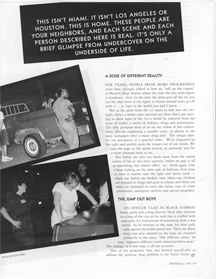
IT’S SHORTLY BEFORE 11 P.M., and another woman is standing with her pale arms outstretched against the trunk of her car; she is leaning against it while being frisked by a female police officer. Her halter top bares her swollen stomach. She’s probably four months pregnant, and she has just swallowed a rock of crack to avoid charges of possession of a controlled substance. As it stands, she’ll probably spend the night in jail for "failure to appear" warrants the police dispatchers have informed the arresting officers about. She’ll also be charged with possession of drug paraphernalia because the beer can found in her car has been crushed in the middle to form a crude crack pipe. Her friend will probably bond her out by morning, and she promises to take care of her car as a policeman in a marked car comes to take her to jail.
A Dose of Different Reality
For years, people from more progressive cities have jokingly jabbed at how we "roll up the carpets" in Bryan/College Station about the time the late news report is broadcast. And, by the time the news goes off the air, you can bet that most of the lights in homes around town go off with it … at least in the world you and I know.
But as the glow from the television starts to fade into the twilight, there’s a whole other universe out there that’s just starting to show signs of life. It’s a world far removed from our sense of reality -- a world of violence, drugs, and prostitution. The only glimpses most of us see are videos of law enforcement officials explaining a murder scene, or photos in the daily newspaper after a major drug raid. The images shatter our perception of a peaceful town. We’re disgusted by the sight and quickly push the images out of our minds. We turn the page to the sports section, or anxiously wait for a more pleasant story to air.
But before we can turn our heads away from the unreal reality of life in this alter universe, before we pass it off as something that doesn’t affect "us," think again. Like a beast lurking on the other side of darkness, from time to time it reaches into the light and shows itself – when our homes are broken into, when our children are exposed to drugs and guns at school, and when our taxes are increased to cover the rising costs of crime prevention, emergency services, and special programs.
The Jump Out Boys

An officer clad in black combat boots, pants, and a long-sleeved, black polo shirt motions to a map of the city on his wall that is riddled with map pins. It’s reminiscent of something from a war movie. As he motions to the map, his shirt pulls tight against his bullet-proof vest. There are about 60 pins inserted on the map, all clustered primarily in two areas. "The different colors," he says, "represent different crack-related problem areas." The analogy to a war map is all too accurate.
One of the programs that was formed specifically to address the growing drug problem is the Street Crime Apprehension Team. It was formed by the Bryan Police Department in October of last year as an aggressive step toward wiping out a relatively new enemy: crack cocaine. Within three years of crack’s arrival on the local scene, Bryan had witnessed an incredible increase in street-level drug dealing. The increase was tied to crack’s cheap price tag: the average cost of a "rock" is $20. A smaller dose of the drug – a "dime" – can be purchased for just $10.
"So many people started selling on street corners to drive-up traffic that one guy in a patrol car wasn’t enough," says Sergeant Mark Ricketson of the SCAT team. "He’d have to make calls and handle all arrests, and that would take him off the street."
While the Brazos Valley and the Department of Public Safety Narcotics Task Forces had been in place a number of years, their primary focus was on the mid- to upper-level drug dealers – those dealers who would bring the drugs into the county and those who would purchase the drugs in surrounding areas and bring them into Bryan and College Station for sale. The search for a solution to the propagating street-level drug sales led Bryan Police Department to Tampa, Florida, where their QUAD (Quick Uniformed Attack on Drugs) team had success in tackling such problems. Bryan sent five officers for training and, on October 24 of 1991, the SCAT team hit the streets.
Since their appearance, SCAT has made nearly 300 arrests. Those have produced nearly 400 misdemeanor charges, 150 felony charges, and they have seized six cars and approximately $8,122 in cash. And the tote board changes almost daily.
"I’d say that 90 percent of the days or nights that we go out, we’re going to end up with an arrest or two," Ricketson says.
What makes this team different, Ricketson says, is that SCAT is a pro-actionary force. Traditionally, law enforcement has been "reactionary" – the police wait for the crime to happen. SCAT is out looking for the guys committing the crimes as they are occurring. To do that, they use several techniques, one of which earned them the street name "The Jump Out Boys." Officers are dropped off to conduct surveillance; when enough evidence of drug activity is witnessed to warrant a probable cause search, the officers move in. Other methods include undercover buys, informants, condemnation of crack houses and nuisance abatement suits to close down establishments that have a long-documented history of drugs and violence.
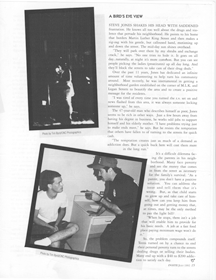
A Bird’s Eye View
Steve Jones shakes his head with saddened frustration. He knows all too well about the drugs and violence that pervade his neighborhood. He points to his home that borders Martin Luther King Street and then makes a zig-zag with his callused hand, motioning up and down the street. The midday sun shines overhead.
"They will park over there by my shrubs and exchange crack," he says. "No one tries to hide it. It goes on all day … naturally, at night it’s more common. But you can see people picking the ladies (prostitutes) up all day long. And they’ll block the streets to take care of their drug deals."
Over the past 11 years, Jones has dedicated an infinite amount of time volunteering to help turn his community around. Most recently, he was instrumental in getting a neighborhood garden established on the corner of M.L.K. and Logan Streets to beautify the area and to create a positive message for the residents.
The 47-year-old man who describes himself as poor, Jones seems to be rich in other ways. Just a few hours away from having his degree in business, he works odd jobs to support himself and his elderly mother. "I have problems trying just to make ends meet," he says. But he resists the temptation that others have fallen to of turning to the streets for quick cash.
"The temptation creates just as much of a demand as addiction does. But a quick buck here will cost them more in the long run."
It’s a difficult dilemma facing the parents in his neighborhood. Many face poverty and see the money that comes in from the street as necessary for the family’s survival. "As a parent, you don’t have a positive solution. You can address the issue and tell them that it’s wrong. But as that child starts to grow up and take care of himself, how can you keep him from going out and getting money that, at times, may be the only method to pay the light bill?
"When he stops, there isn’t a job that will enable him to provide for his basic needs. A job at a fast food place paying minimum wage won’t do it."
So, the problem compounds itself. Teens turned on by a chance to end their personal poverty turn to the streets dealing drugs or selling their bodies. Many end up with a $40 to $200 addiction to satisfy each day.
"I’ve seen them leave their small children at home alone to go out and do rock," Sergeant Ricketson of SCAT says. "I’ve seen them sell all their furniture and have their families go without food to buy rock.
"Those are the people who are the innocent victims, and they’re the reason we’re out there."
">SCAT’s presence has made some waves in Jones’ neighborhood. He says that since SCAT hit the streets, the dealers have moved off some of the busier streets and more to the side streets. They’ve also become more organized and have developed hand signals to let each other know when the officers are out. "It makes them virtually impossible to get caught," Jones says.
Catch as Catch Can
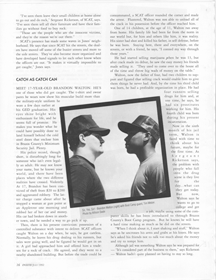
Meet 17 year old Brandon Walton. He’s one of those who did get caught. The t-shirt and sweat pants he wears now show his muscular build more than the military-style uniform he wore a few days earlier at his GED graduation. His eyes shine bright with enthusiasm for life, and he seems full of promise. He makes you wonder what he could have possibly done to land himself behind the cold steel doors that enclose him in Brazos County’s Minimum Security Jail. Plenty.
His police record, though short, is disturbingly long for someone who isn’t even an legal adult. He may not know your name, but he knows your world, and there have been places where the two different realities have crossed. Violently. At 17, Brandon has been convicted of theft from $20 to $200 and aggravated robbery. The latter charge came about after he stopped a woman at gun point at an Appletree grocery store one morning and robbed her of her car and money. His car had broken down in another town, and he needed a way to pick it up.
Then, there is this present conviction: possession of a controlled substance with intent to deliver. SCAT officers caught Walton on a day when, he says, he got careless. Normally, he leaves his drug dealing to his runners, but sales were going well, and he figured he would get in on it. A girl had approached him and offered him a trade: sex for a rock of crack. He agreed, and they went to a nearby abandoned building. But before the trade could be consummated, a SCAT officer rounded the corner and made the arrest. Flustered, Walton was not able to unload all of the crack in his possession before the officer reached him.
One of 14 children, at the age of 11 Walton ran away from home. His family life had been far from the norm in our world but, for him and others like him, it was reality. His sister had shot and killed his father, in self defense, before he was born. Staying here, there, and everywhere, on the streets or with a friend, he says, "I conned my way through the years."
He had started selling marijuana when he was 13, but after crack made its debut, he saw the easy money his friends made selling it. "They used to come over to the house all of the time and throw big wads of money on the table."
>Walton, now the father of four, had two children to support at the time and figured selling crack would enable him to give them things he never had. And, by the time his third child was born, he had a profitable organization in place. He had four runners selling drugs for him and, at one time, he says, he had six prostitutes working for him. His fourth child was burn during his present incarceration.
Now in the sixth month of his jail term, Walton is faced with time to think about his future, maybe for the first time. As Sergeant Ricketson says, the problem with people who fall into the drug scene is they live for the day. But now, Walton says he wants to go to college and get a job, maybe using some of the computer skills he has been introduced to through Brazos County’s Boot Camp program. But he knows he will have a hard time making as much as he did on the streets.
"When I think about it, I start shaking and stuff," Walton says as he crosses and uncrosses his arms and grabs at his knees. He says he’s asked his friends not to talk too much about the money and try to tempt him.
Although jail was something Walton says he was prepared for – "It’s considered to be part of the business to them," says Ricketson – Walton hadn’t quite planned on having to stay so long.
Where’s The Fire?
Occupational hazards. Talk to a local paramedic about that. The men at both Bryan and College Station’s Central Fire Stations stand ready for the worst to happen. And, when it does, they roll, uncertain exactly what waits for them at the end of their call.
Bryan Assistant Fire Chief Mike Donoho arches hi eyebrows and shakes his head with worry. "The last couple of months, we’ve had a lot of drug-related violence calls," he says. "That makes our job as a rescuer more difficult. If someone is hurt, he was meant to be hurt and stay hurt. And, if our paramedics show up to help, there’s a chance someone might attempt to injure our crews." Policy now is to wait for the police to show up on violence calls before rendering aid.
"We stay especially busy in this area of North Bryan," he adds. "We see things that we’ve never seen before." He uses the recent crack-related bludgeoning of a Bryan man and the murder of a woman who was mowed down with a car as examples. Those calls came during the same week in June.
With just two ambulances in both cities and calls on the increase, it has become a common occurrence to call on an agreement between Bryan and College Station that allows a city with all of its ambulances tied up to call the neighboring city for aid.
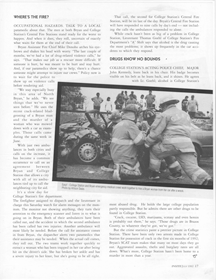
Occupational hazards. Talk to a local paramedic about that. The men at both Bryan and College Station’s Central Fire Stations stand ready for the worst to happen. And, when it does, they roll, uncertain exactly what waits for them at the end of their call.
Bryan Assistant Fire Chief Mike Donoho arches hi eyebrows and shakes his head with worry. "The last couple of months, we’ve had a lot of drug-related violence calls," he says. "That makes our job as a rescuer more difficult. If someone is hurt, he was meant to be hurt and stay hurt. And, if our paramedics show up to help, there’s a chance someone might attempt to injure our crews." Policy now is to wait for the police to show up on violence calls before rendering aid.
"We stay especially busy in this area of North Bryan," he adds. "We see things that we’ve never seen before." He uses the recent crack-related bludgeoning of a Bryan man and the murder of a woman who was mowed down with a car as examples. Those calls came during the same week in June.
With just two ambulances in both cities and calls on the increase, it has become a common occurrence to call on an agreement between Bryan and College Station that allows a city with all of its ambulances tied up to call the neighboring city for aid.

It’s a slow day for College Station’s fire department. The firefighter assigned to dispatch and the lieutenant in charge this Saturday watch for alarm messages on the monitors. The monitor is not showing anything. They turn their attention to the emergency scanner and listen in to what is going on in Bryan. Both of their ambulances have been called out, and the accident to which the second ambulance has been called has two injuries. Another ambulance will most likely be needed. Before the call for assistance comes in from Bryan, the dispatcher alerts two paramedics that their assistance may be needed. When the actual call comes, they roll out. The two teams work together quickly to extract a woman who has been trapped in her car after being hit on the driver’s side. She has broken her ankle and has a severe injury to her knee, but she’s going to be all right.
That call, the second for College Station’s Central Fire Station, will be its last of the day. Bryan’s Central Fire Station will have responded to nine calls by day’s end – not including the calls the ambulances responded to without the engines.
While crack hasn’t been as big of a problem in College Station, Lieutenant Thomas Goehl of College Station’s Fire Department’s "A" Shift says that alcohol is the drug causing the most problems; it shows up frequently in the car accidents to which they respond.
Drugs Know No Bounds
College Station’s acting police chief, Major John Kennedy, leans back in his chair. His badge becomes visible on his belt as he leans back, and it shines. He agrees with Lt. Goehl; alcohol is College Station’s most abused drug. He holds the large college population at Texas A&M and Blinn universities partly responsible. But he admits there are other drugs to be found in College Station.
"Crack, cocaine, LSD, marijuana, ecstasy, and even heroin is probably out there," he says. "Those drugs are in Brazos County, so whatever they’ve got, we’ve got."
But the crime statistics paint a prettier picture in College Station. There have been only two arrests made in College Station for possession of crack in the first six months of 1992; Bryan’s SCAT team makes that many on most days they go out. Aggravated assaults, thefts, and burglary rates are all down. What’s more, College Station hasn’t been home to a murder in more than a year.
So, what's so special about College Station? It's probably more a factor of demographics and the city's age, Kennedy says.
"Even though we border Bryan, there's a difference in population," he says. "College Station's average age is somewhere around 22. We're newer than Bryan, and our geographical layout of the city is quite a bit different."
He's right about that, but Mike Williamson, senior resident agent for the Federal Bureau of Investigation in Bryan, says he thinks College Station is ignoring things. One of the FBI's biggest busts came from an investigation of a cocaine dealer operating in College Station. And Bryan's problems today may be College Station's problems tomorrow. he says that, as Bryan's SCAT team makes crack dealing more difficult, those dealers will move to other ground ... that may mean College Station. To date, Kennedy says neither drug related arrests nor citizen input have warranted a program like SCAT, but they have established a substation in a potential "at risk" area and have three officers assigned to the Brazos Valley Narcotics Task Force.
Back in Brazos County's Minimum Security Jail, Brandon Walton agrees with Special Agent Williamson about drugs in College Station.
"A lot of people sell in College Station," he says. "They don't stay in one place like they do here, and they only sell to people they know." Before he got caught, he says he had plenty of customers coming in from College Station. he says once there's a market, which could come from SCAT making it more difficult in Bryan, more dealers will move into College Station.
All Before the Morning Bird Sings in Suburbia
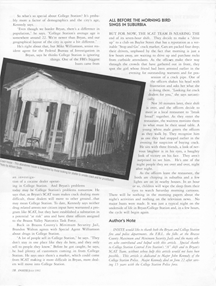
But, for now, the SCAT team is nearing the end of its seven-hour shift. They decide to make a "drive up" to a club on Baylor Street in Bryan that has a reputation as a veritable "Stop and Go" crack market. Cars are parked four deep; their drivers, unfazed by the fact that morning is just a few hours away, are waiting to drive up to purchase rocks of crack from curbside attendants. As the officers make their way through the crowds that have gathered out in front, they spot the girl whose friend had been arrested earlier in the evening for outstanding warrants and for possession of a crack pipe. One of the officers shakes his head with frustration and asks her what she is doing there. "Looking for crack dealers for you," she says sarcastically.
Not 30 minutes later, their shift is over, and the officers decide to meet at a local restaurant to "break bread" together. As they enter the restaurant, the waitress motions them to what must be their usual table. A young white male greets the officers as they walk by. They recognize him as the one they had stopped earlier in the evening for suspicion of buying crack. He sits with three friends, a look of nervous laughter is in his eyes, a haughty look of victory on his face. They aren't surprised to see him. He's one of the night people they see over and over, night after night.
As the officers leave the restaurant, the birds are chirping in suburbia and a few lights are on in nearby houses. In an hour or so, children will wipe the sleep from their eyes to watch Saturday morning cartoons. There will be nothing in the morning papers about the night's activities and nothing on the television news. No major busts were made. It was just a typical night on the underside of life in Bryan/College Station and, in a few hours, the cycle will begin again.
